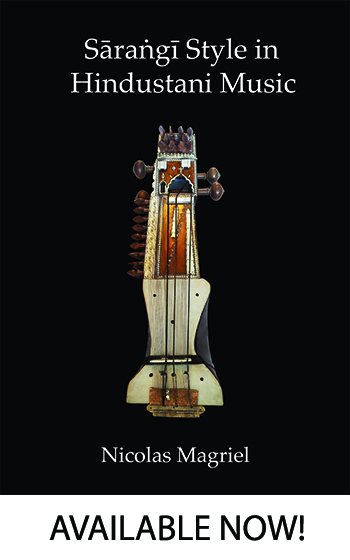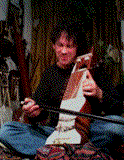
Ustad Ghulam Sabir Qadri was a sweet old-style sarangi player from Moradabad in UP. When I met him, he was retired from his job as a staff artist at the Delhi station of All India Radio ahere he had been for several years. He had the AIR "Top Class" distinction. Previously he had been at the radio station in Lucknow since the 1940s and had accompanied many great singers: Begum Akhtar, Faiyaz Khan, Vinayakrao Patwardhan, D V Paluskar—to name a few. Born in 1922, Ghulam Sabir Qadri's teachers include his father Hussain Bakhsh, his elder brother Maqbul Hussain Varsi, his sister's husband Altaf Hussain and the vocalist Tajammul Hussain.
Charismatic and quirky, his bright eyes always glistened out from behind his dense whiskers. His main sarangi was a rare mevati sarangi with a scroll-shaped peghead—something some instrument maker somewherei came up with having observed Victorian table legs or foreign craftsmen at work. Ghulam Sabir Qadri was devout and level-headed. I learned from him on-and-off beginning in the autumn of 1994 in his home across the Yamuna river in Delhi. Usually I would sit together with him and his two teenage students Karam Waris and Vikki. There was a wonderful uproar when all four of us practiced scales together.
Ghulam Sabir Qadri specialised in the jor-ang of sarangi, a predominently rhythmic alap style. Probably the best-known exponent of this somewhat naive but beautiful style was the Jajar sarangiya Abdul Majeed Khan, a student and friend of Bundu Khan's, who was the unrivalled singer Kesarbai Kerkar's faithful accompanist for many years—an arrangement which came to an end with her fury upon realising that he had taught some of "her" Jaipur-Atrauli compositions to his sons, the singers Abdul Sayeed and Abdul Rashid Khan.
Ghulam Sabir taught me several rare rags of which Saurastra Bhairav is my favorite. The videos here are mostly of our lessons, sometimes of him demonstrating particular rags or stylistic features. His style and presence were rustic and funky: he didn't have a clearly articulated solo style, but wonderful enthusiasm and diverse knowledge shine through his somewhat scratchy presentation.
We begin with my first visit to his house on September 26th, 1994. Somewhat non-plussed by my arrival out of the blue, he proceeded to demonstrate many rags, without a great deal of attention to development—he said himself "to play a rag properly takes a long time" which I guess he presumed I didn't have, being a foreigner.
We started with talking—making contact:
It was around noon, so Ghulam Sabir Qadri started with rag Brindabani Sarang:
Then he surprised me with the beautifyl Saurastra Bhairav which I'd never heard before. He declined to tell me the rag's name until several days later.
This was followed by short demos of several rags:
And more demos of diverse rags including two angs of Kaushi Kanada:
I returned on the 29th of September and listened to his students Karam Waris Khan and Vikki (Akram Hussain) practising together and playing rag Salab Baraily, their lesson in Miyanki Malhar and some other rags including Kedar, Malhar and the boys alone doing Nat Bhairav. Today I'm feeling lazy about separating all of this into individual files. Too time consuming—want to get on with other things. If you have a fast connection, you should be able to move around in the recording easily.
(newly added January 2025) Also from September 29, 1994, one of the Ustad's favourite rags—Saurashtra Bhairav—to which we will return several times:
The next three videos are from November 1, 1994:
First rag Rageshri in which GSQ teaches me one of my favourite songs "sajana bina main udaas", one of the taan-pradhan bandishes which sound so nice on sarangi:
Then a wonderful Bhairavi tappa followed by a beautiful bandish ki thumri which I had learned twenty years earlier in Banaras.
Finally rag Puriya and some discussion:
Next I present two videos from a visit on October 10, 1995. The first is a lesson in the beautiful rare rag Saurastra Bhairav:
Then GSQ demonstrated the contrasting close neighboors Sohini, Marva and Bareri:
The next video is from June 2, 1997. Ghulam Sabir Qadri plays alap and vilambit and drut bandishes and tans in rag Suha:
Now we have Rag Puriya Kalyan—two versions—played on June 5, 1997 and June 17, 1997:
New videos uploaded May 2024:
The first two videos below are from a visit on September 29th, 1994—one of my first visits to GSQ's house. First there was some scale practice in rag NatBhairav with his students Karam Waris and Akram Husain:
The boys played rag Ramkali while the Ustad and I talked, and then there was more talk. GSQ discussed the importance of shagirdi for blessing the teacher-student relationship. He also talked about how essential sargam syllables are for musical transmission and also the importance for sarangi players of knowing the songtexts of bandishes, imbibing the emotions inherent in the music.
A week later, on the 6th of October, he played rag Todi delicately, and i followed on my sarangi:
Followed by rag Bhairav, a sargam bandish, a type of composition given to beginners such as GSQ's elderly South-Indian student Das who sits on the left. Several fairly standard "fixed" tans are taught and practised:
And finally rag Puriya, teaching us a bandish:
(newly added January 2025) three miscellaneous videos from the same day. Firstly the Ustad shared some photos. It was touching to say a photo of his mother and a drawing of his father with sarangi, and a photo of GSQ as a young man, looking very dashing in a jacket and tie. We see him, also as a young man, playing in an orchestra in Lucknow. The clip ends with has staff pass for All India Radio, Lucknow.
Then he played an unusual and as yet unidentified rag on my sarangi:
And now some glimses of the family:
The next four pieces are from a visit on October 12, 1994. First rag Ahir Bhairav:
Then GSQ's specialty, Rag Saurashtra Bhairav:
Followed by Bhairavi:
Then rag Salag Barari and some brief peaks at other rags:
Then a look at the Ustad's biodata from a concert flyer:
This next series is from a visit on October 5th, 1996. The first video shows Ghulam Sabir Qadri tuning, his students Karam Waris Khan and Akram Hussain practising,and various home activities—life in a musical household:
Then Ghulam Sabir Qadri played his version of the wonderful rag Lalit Pancham, which unlike the Jaipur-Atrauli vocal gharana version, is more like rag Lalit with the note Pa added:
Then the complex morning rag Bhatiyar:
The thumri mood ovetook him, and he plays Pilu:
The session ended with Bhairavi:



